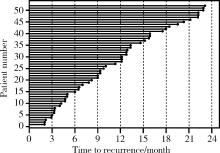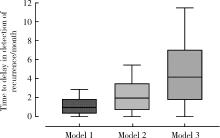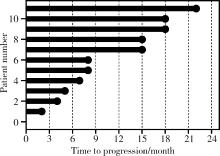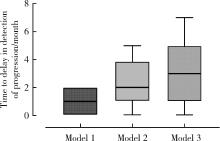Journal of Peking University (Health Sciences) ›› 2022, Vol. 54 ›› Issue (4): 669-673. doi: 10.19723/j.issn.1671-167X.2022.04.014
Previous Articles Next Articles
Optimal surveillance intensity of cystoscopy in intermediate-risk non-muscle invasive bladder cancer
Fei WANG,Cai-peng QIN,Yi-qing DU,Shi-jun LIU,Qing LI,Tao XU*( )
)
- Department of Urology, Peking University People's Hospital, Beijing 100044, China
CLC Number:
- R737.1
| 1 | 李辉章, 郑荣寿, 杜灵彬, 等. 中国膀胱癌流行现状与趋势分析[J]. 中华肿瘤杂志, 2021, 43 (3): 6. |
| 2 | 陈晓芳, 陈万青, 周薇薇, 等. 2013年中国膀胱癌发病和死亡流行状况分析[J]. 中国肿瘤, 2018, 27 (2): 5. |
| 3 |
Kamat AM , Hahn NM , Efstathiou JA , et al. Bladder cancer[J]. Lancet, 2016, 388 (10061): 2796.
doi: 10.1016/S0140-6736(16)30512-8 |
| 4 |
Babjuk M , Burger M , Compérat EM , et al. European association of urology guidelines on non-muscle-invasive bladder cancer (TaT1 and carcinoma in situ): 2019 update[J]. Eur Urol, 2019, 76 (5): 639- 657.
doi: 10.1016/j.eururo.2019.08.016 |
| 5 |
Rhijn B , Burger M , Lotan Y , et al. Recurrence and progression of disease in non-muscle-invasive bladder cancer: from epidemio-logy to treatment strategy[J]. Eur Urol, 2009, 56 (3): 430- 442.
doi: 10.1016/j.eururo.2009.06.028 |
| 6 |
Burger M , Catto JW , Dalbagni G , et al. Epidemiology and risk factors of urothelial bladder cancer[J]. Eur Urol, 2013, 63 (2): 234- 241.
doi: 10.1016/j.eururo.2012.07.033 |
| 7 |
Chang SS , Boorjian SA , Chou R , et al. Diagnosis and treatment of non-muscle invasive bladder cancer: AUA/SUO guideline[J]. J Urol, 2016, 196 (4): 1021- 1029.
doi: 10.1016/j.juro.2016.06.049 |
| 8 |
Ritch CR , Velasquez MC , Kwon D , et al. Use and validation of the AUA/SUO risk grouping for nonmuscle invasive bladder cancer in a contemporary cohort[J]. J Urol, 2020, 203 (3): 505- 511.
doi: 10.1097/JU.0000000000000593 |
| 9 |
Han C , Mengual L , Kang B , et al. Validation of urine-based gene classifiers for detecting bladder cancer in a chinese study[J]. J Cancer, 2018, 9 (17): 3208- 3215.
doi: 10.7150/jca.24506 |
| 10 |
Zhu CZ , Ting HN , Ng KH , et al. A review on the accuracy of bladder cancer detection methods[J]. J Cancer, 2019, 10 (17): 4038- 4044.
doi: 10.7150/jca.28989 |
| 11 |
Nielsen ME , Smith AB , Meyer AM , et al. Trends in stage-specific incidence rates for urothelial carcinoma of the bladder in the United States: 1988 to 2006[J]. Cancer, 2014, 120 (1): 86- 95.
doi: 10.1002/cncr.28397 |
| 12 | Martin DT , Shen H , Steinbach-Rankins JM , et al. Glycoprotein-130 expression is associated with aggressive bladder cancer and is a potential therapeutic target[J]. Mol Cancer Ther, 2018, 18 (2): 413- 420. |
| 13 |
Mason SJ , Downing A , Wright P , et al. Health-related quality of life after treatment for bladder cancer in England[J]. Br J Can-cer, 2018, 118 (11): 1518- 1528.
doi: 10.1038/s41416-018-0084-z |
| 14 |
Kamat AM , Witjes JA , Brausi M , et al. Defining and treating the spectrum of intermediate risk nonmuscle invasive bladder cancer[J]. J Urol, 2014, 192 (2): 305- 315.
doi: 10.1016/j.juro.2014.02.2573 |
| 15 |
Bhat A , Kwon D , Soodana-Prakash N , et al. Surveillance intensity in intermediate risk nonmuscle invasive bladder cancer: revisiting the optimal timing and frequency of cystoscopy[J]. J Urol, 2021, 206 (1): 22- 28.
doi: 10.1097/JU.0000000000001689 |
| 16 |
Soria F , D'Andrea D , Abufaraj M , et al. Stratification of intermediate-risk non-muscle-invasive bladder cancer patients: implications for adjuvant therapies[J]. Eur Urol Focus, 2021, 7 (3): 566- 573.
doi: 10.1016/j.euf.2020.05.004 |
| 17 |
Kohada Y , Ha Yashi T , Hsi RS , et al. Recurrence and progression free survival of intermediate risk non-muscle invasive bladder cancer: the impact of conditional evaluation and sub-classification[J]. BJU Int, 2021, 127 (4): 473- 485.
doi: 10.1111/bju.15209 |
| 18 |
Fukushima H , Moriyama S , Waseda Y , et al. Significance of bladder neck involvement in risk substratification of intermediate-risk non-muscle-invasive bladder cancer[J]. Eur Urol Focus, 2021, 7 (2): 366- 372.
doi: 10.1016/j.euf.2020.01.006 |
| 19 |
Reyes RM , Rios E , Barney S , et al. A randomized feasibility trial comparing surveillance regimens for patients with low and low-intermediate risk non-muscle invasive bladder cancer[J]. Bladder Cancer, 2021, 7 (3): 285- 295.
doi: 10.3233/BLC-201535 |
| 20 | Wallace D , Bryan RT , Dunn JA , et al. Delay and survival in bladder cancer[J]. BJU Int, 2015, 89 (9): 868- 878. |
| [1] | Huan-rui LIU,Xiang PENG,Sen-lin LI,Xin GOU. Risk modeling based on HER-2 related genes for bladder cancer survival prognosis assessment [J]. Journal of Peking University (Health Sciences), 2023, 55(5): 793-801. |
| [2] | DAI Xiang,ZUO Mei-ni,ZHANG Xiao-peng,HU Hao,XU Tao. Comparison of long-term outcomes in different managements of diverticular neck in percutaneous nephrolithotomy for diverticular calculi [J]. Journal of Peking University (Health Sciences), 2021, 53(4): 704-709. |
| [3] | Ming-rui WANG,Qi WANG,Hao HU,Jin-hui LAI,Yong-xin HE,Jie XIONG,Xian-hui LIU,Shi-jun LIU,Ke-xin XU,Tao XU. Long-term analysis of safety and efficacy of standard percutaneous nephrolithotomy in patients with solitary kidneys [J]. Journal of Peking University (Health Sciences), 2020, 52(4): 663-666. |
| [4] | Yu-hui LI,Bo SU,Fu-an LIN,Ya-nan FEI,Xiao-xia YU,Wen-qiang FAN,Hai-ying CHEN,Xue-wu ZHANG,Yuan JIA. Cross-sectional study on clinic behavior and therapeutic status of patients with psoriatic arthritis in multi-center [J]. Journal of Peking University(Health Sciences), 2019, 51(6): 1014-1018. |
| [5] | Fei-long YANG,Kai HONG,Guo-jiang ZHAO,Cheng LIU,Yi-meng SONG,Lu-lin MA. Construction of prognostic model and identification of prognostic biomarkers based on the expression of long non-coding RNA in bladder cancer via bioinformatics [J]. Journal of Peking University(Health Sciences), 2019, 51(4): 615-622. |
| [6] | ZHANG Hai-dong, ZHANG Li, SHI Dong, HAN Jie, YAN Xia, XIE Ye-si, MENG Huan-xin. Clinical study of locking-taper implants in patients treated for periodontitis [J]. Journal of Peking University(Health Sciences), 2018, 50(2): 300-307. |
| [7] | WANG Nan, ZHAO Yu-ming. Retrospective study of dental treatment under general anesthesia of 62 disabled children and adolescents [J]. Journal of Peking University(Health Sciences), 2018, 50(2): 293-299. |
| [8] | YAO Lin, ZHANG Lei, FAN Yu, ZHANG Zheng, XU Yan-Peng, LIU Ming-Jie, HE Zhi-Song, GONG Kan, LI Xue-Song, ZHANG Zheng, ZHANG Cui-Jian, ZHOU Li-Qun. A prospective randomized control study: new rigid cystoscopy technology to improve patients’ comfort [J]. Journal of Peking University(Health Sciences), 2014, 46(4): 635-637. |
| [9] | SHEN Qi, HU Shuai, LI Jun, WANG Jing-Hua, HE Qun. Incidence and clinicopathological characteristics of incidental prostatic adenocarcinoma in radical cystoprostatectomy specimens [J]. Journal of Peking University(Health Sciences), 2014, 46(4): 515-518. |
|
||







